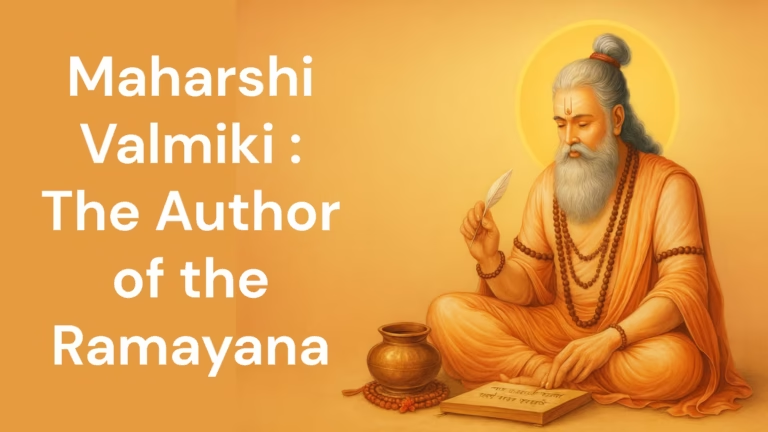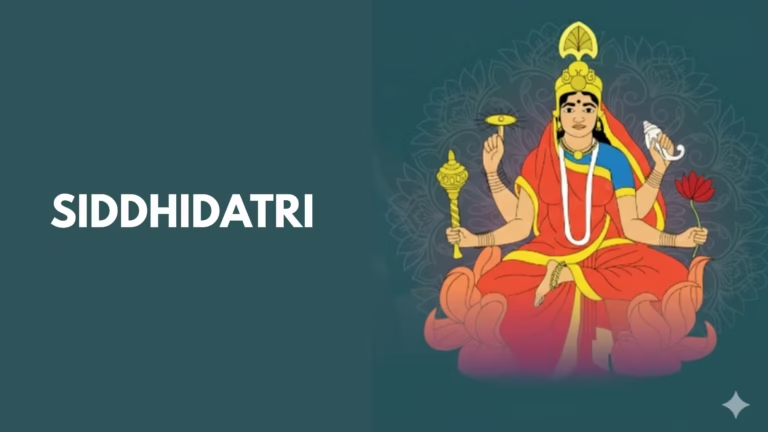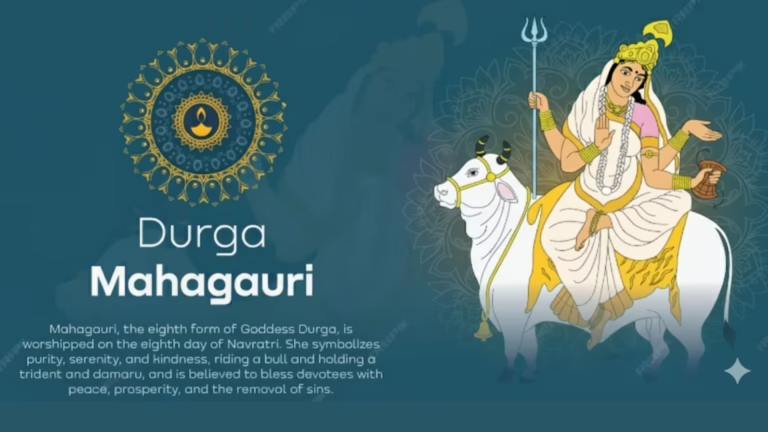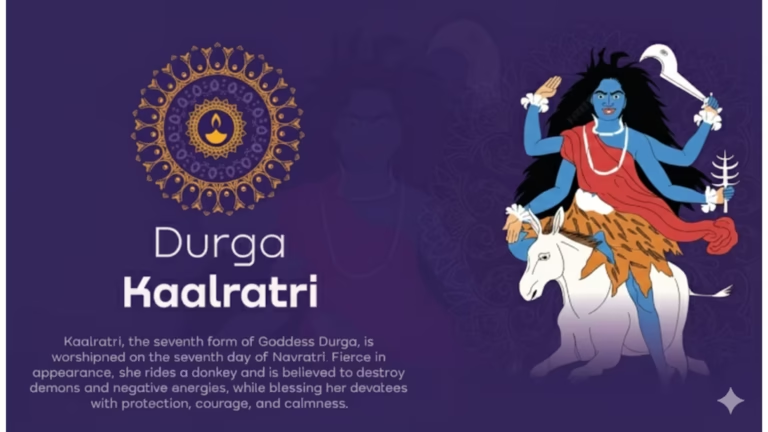If you’ve ever wondered who Asur King Bali was and what his relation with Prahlad reveals about dharma, humility, and leadership, this guide brings the story—and its lessons—alive.—
Who was Asur King Bali?
In Hindu tradition, Asur King Bali—widely revered as Mahabali—stands out as a paradox: a ruler from the Asura lineage who nonetheless shines as a model of truthfulness, charity, humility, and devotion. Though an Asura by birth, Bali is celebrated in many parts of India for his justice and generosity, and in Kerala he is lovingly remembered during Onam. His fame rests primarily on his extraordinary encounter with Vishnu’s Vāmana (Vamana) avatar, where Bali offers everything he owns to the dwarf Brahmin who is, in fact, the Supreme Lord in disguise. Far from being a simple tale of conquest, Bali’s story is a meditation on ego and surrender, kingship and dharma, wealth and true greatness.
This article answers two essential questions: Who was King Bali? and What is his relation with Prahlad (Prahlāda), the legendary devotee of Lord Vishnu. By tracing Bali’s lineage, exploring the Puranic narratives, and reflecting on the spiritual lessons, we discover why this Asura king is honored across regions and traditions despite the usual Deva–Asura polarity.
Lineage of King Bali
To understand Bali’s character, we begin with his family line, which anchors him deeply in the devotional stream of Vaishnava lore. Bali is the grandson of Prahlad (Prahlāda), one of the most celebrated devotees of Vishnu, and the son of Virochana. This ancestry is significant: it means Bali inherits a dual legacy—Asura power and Vaishnava devotion. Even as he expands his empire and asserts Asura dominance, his actions often reflect a consciousness shaped by dharma rather than raw ambition.
Prahlad → Virochana → Bali: this simple sequence is packed with meaning. Prahlad’s unwavering devotion to Vishnu survives demonic persecution under his own father, Hiranyakashipu. Virochana, Prahlad’s son, is generally portrayed as dutiful but not as spiritually radiant as his father. Bali, Virochana’s son, fuses political prowess with religious humility. He becomes known for satya (truthfulness) and dāna (charity)—qualities that later frame his decisive meeting with Vamana.
Bali’s upbringing emphasizes kingly virtues: protection of subjects, fairness in taxation, respect for ascetics and Brahmins, and commitment to promises. His court, while powerful, is not a place of arrogance alone; the Puranic image balances valor with virtue. When Bali eventually confronts Vishnu in the guise of Vamana, his response is conditioned by this moral training: a king must keep his word—even if the cosmos trembles at the consequence.
Prahlad: The Devotee of Lord Vishnu
Prahlad is one of Hinduism’s finest icons of bhakti (devotion). As the son of the fierce Asura king Hiranyakashipu, he endures relentless persecution for refusing to abandon his love for Vishnu. Miraculously protected by the Lord at every turn, Prahlad’s story culminates in the appearance of Narasimha, the man-lion avatar who ends Hiranyakashipu’s tyranny.
For our present subject, Prahlad’s legacy matters in two ways. First, he represents the truth that devotion transcends birth: a child born in an Asura household can be an exemplar of divine love. Second, he shows that dharma can challenge power when power becomes oppressive. These lessons echo in Bali’s reign—especially in the way he receives Vamana’s request.
Prahlad’s presence in Bali’s lineage is more than genealogy; it is a spiritual inheritance. Even if Bali’s political ambitions lead him to confront the Devas, a thread of devotional ethos remains visible. That’s why Bali is portrayed not as a villain but as a noble adversary—someone whom even the Devas, and ultimately Vishnu, honor.
The Relation Between King Bali and Prahlad
The relationship is direct and defining: King Bali is the grandson of Prahlad. This connection clarifies why Bali, despite being an Asura monarch, is often depicted with moral grandeur and devotional sensitivity. Prahlad’s unshakable faith in Vishnu shapes the ethical environment in which Bali is raised.
Where Prahlad is the prototypical bhakta whose inner devotion transforms the world, Bali is the rājā-bhakta—a king whose devotion is tested in the arena of power, wealth, and public duty. Their stories mirror each other in unexpected ways: Prahlad keeps faith when threatened with death; Bali keeps faith when asked to surrender everything. Both choose Vishnu over ego, even though their tests differ.
Understanding this relationship also dissolves simplistic binaries. The Asura–Deva divide is not equivalent to evil–good in absolute terms. Both Prahlad and Bali reveal that dharma and devotion can emerge in any lineage. Bali’s nobility is not a departure from his family; it is, in some sense, a fulfillment of Prahlad’s spiritual legacy.
King Bali in Puranic Stories
King Bali’s story is woven across multiple Puranas, with the Bhagavata Purana (Śrīmad Bhāgavatam, Skandha 8) offering the most detailed narrative of his interaction with Vamana. The Vishnu Purana and Vamana Purana also preserve variations that accentuate different theological angles—Bali’s charity, the restoration of cosmic balance, and Vishnu’s protection.
In these accounts, Bali is a formidable emperor whose austerity, strategic acumen, and valor allow him to consolidate power across the three worlds. Unlike some other Asura kings, Bali is not defined by wanton cruelty. He seeks to rule justly, winning the loyalty of his subjects. The Devas, however, suffer under his meteoric rise, and cosmic order seems tilted. In the classical Purāṇic rhythm, such an imbalance calls for divine intervention—not simply to defeat Bali, but to correct the disequilibrium while honoring Bali’s virtue.
The texts emphasize Bali’s two hallmarks: truth and giving. His renown for dāna becomes both the instrument of his spiritual elevation and the context for his humbling. This paradox is central to his legend: the very quality that makes him great as a king also becomes the stage upon which he learns supreme surrender.
The Vamana Avatar and King Bali
The heart of Bali’s story is his encounter with Vamana, Vishnu’s fifth avatar in the Dashavatara sequence (if counting Vamana distinct from Trivikrama). Disguised as a young Brahmin dwarf, Vamana arrives at the site of Bali’s Viśvajit yajña (described in the classical accounts as being performed at Bhrigu-kaccha on the Narmadā), where the king is distributing gifts to Brahmins and sages. Some retellings generalize this as a grand sacrificial session, but the primary narrative specifies the Viśvajit rite. In this sacred moment, refusing a request would be a blot on the king’s honor.
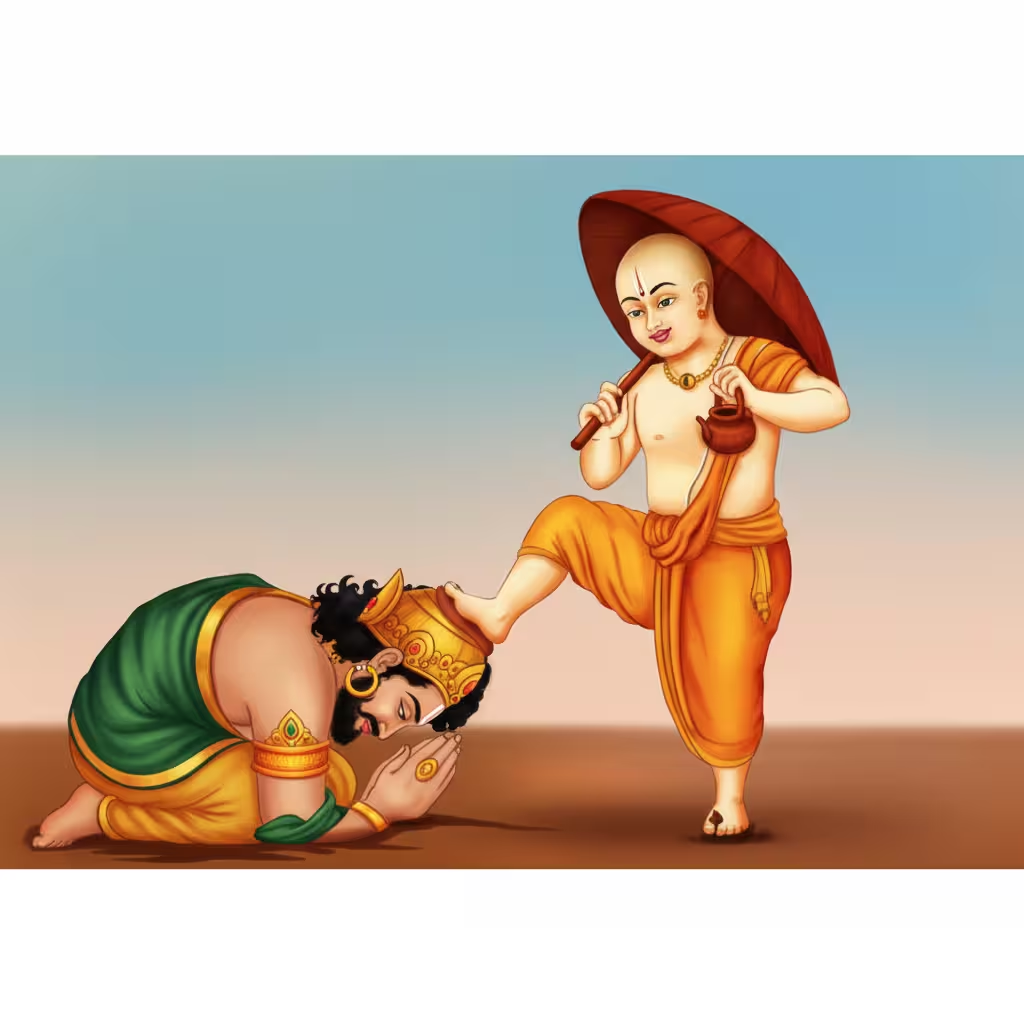
When Vamana asks for “three steps of land”, Bali is amused by the simplicity of the request. His advisor and guru Śukrācārya, however, recognizes the true identity of the visitor and warns Bali not to proceed. The caution is political and cosmic: granting even a seemingly small boon to the Supreme Lord could undo Bali’s conquests.
Here, Bali’s character blazes forth. He insists that a king who has made a vow of generosity cannot go back on his word. If the petitioner is in fact Vishnu, then giving is not a loss but a blessing. Bali replies that truthfulness and charity are the ornaments of kingship; without them, political authority is hollow. He pours sacred water to seal the promise.
The moment the vow is sanctified, Vamana begins to expand—no longer a dwarf but the cosmic Trivikrama, whose first stride spans the earth, and the second reaches the heavens. With two steps, Vishnu covers all domains Bali claimed. There is no space left for the third step.
Vishnu asks: Where shall I place my third step? Bali responds with the ultimate act of surrender: he bows his head and offers it as the third step. The Lord places his foot on Bali’s head—not as humiliation, but as consecration. In many retellings, this gesture purifies Bali’s residual ego and crowns his devotion.
The aftermath is equally instructive. Vishnu does not annihilate Bali. Instead, he assigns him rulership of Sutala, a splendid subterranean realm, and promises to stand as Bali’s doorkeeper—a profound symbol that divinity guards the devotee who has offered everything. Cosmic balance is restored—the Devas regain their territories—but Bali’s honor is preserved and his devotion validated. Thus, the Vamana episode is not about the defeat of an enemy; it is the elevation of a devotee.
The Ethical Core of the Three Steps
The spiritual force of this story lies in its ethical core. The first step represents the return of earthly order; the second step restores celestial harmony; the third step—taken upon Bali’s own self—signifies inner surrender. Rulership of worlds without mastery of self is incomplete. Bali’s greatness is that he chooses truth over power, promise over possession, and devotion over dominion.
Why King Bali is Remembered in Hindu Tradition
Bali is remembered for more than his dramatic meeting with Vamana. He embodies a cluster of virtues that Hindu thought holds dear:
Truthfulness: He keeps his word even when warned of catastrophic loss. For Bali, dharma is not conveniently negotiable; it is the spine of sovereignty.
Generosity: His name is synonymous with dāna. The request for three steps is not a trap; it is a test he willingly passes by placing honesty above hegemony.
Humility: Bowing his head for the third step is not defeatist; it is devotional courage—choosing self-offering over self-assertion.
Devotion: The outcome—Vishnu’s guardianship at Sutala—testifies that Bhagavān recognizes true bhakti wherever it shines, Asura or Deva.
Because of these qualities, Bali is revered as Mahābali—great Bali. His story teaches that the measure of a king is not the breadth of his empire but the depth of his integrity.
King Bali and Festivals
Across India, Bali’s memory is alive in regional festivals that celebrate his reign and virtues. In Kerala, the harvest festival Onam honors Mahabali’s annual visit to his people. The popular sentiment holds that Bali’s rule was so just and prosperous that his subjects long for his return, and Onam commemorates that golden age. Houses are decorated with pookkalam (flower rangoli), families share festive meals, and communities engage in boat races, dances, and cultural programs—in affectionate remembrance of a king who cared for his people.
In western India, especially Maharashtra and Gujarat, the day after Diwali is observed as Bali Pratipada (also called Balipratipada or Padva). The celebration symbolizes Bali’s honor and well-being even after the cosmic reordering by Vamana. Families mark the day with auspicious rituals, new beginnings, and expressions of gratitude and loyalty within households. The festival underscores a nuanced truth: even when divinely checked, Bali is not disgraced—he is blessed.
That two distinct festivals commemorate Bali—Onam and Bali Pratipada—illustrates how regional cultures channel the same spiritual admiration through different seasonal idioms. Whether as a just king returning to visit his subjects or as a devotee honored by the Lord, Bali stands as a reminder that righteousness and compassion are the true foundations of public life.
Spiritual Significance of the Bali–Prahlad Lineage
The Bali–Prahlad lineage offers a layered spiritual teaching. Prahlad represents the pure heart that clings to the Divine even when the world turns hostile. Bali represents the responsible hand that must choose between oath and ambition in the public sphere. Prahlad’s devotion happens under familial persecution; Bali’s devotion unfolds in statecraft. Together, they affirm that bhakti can flower in any soil—in a palace or a prison, under threat or in triumph.
Their stories also dismantle rigid notions of good guys and bad guys based purely on birth. The Asura label does not predetermine moral failure, nor does Deva identity guarantee virtue. What matters in the Purāṇic imagination is dharma—the alignment of action with truth. Prahlad and Bali reveal a continuum of devotion running through the Asura family itself, making the point that the Divine belongs to all who choose Him.
From a philosophical perspective, Bali’s surrender teaches the Vedantic insight that ownership is illusory. Kingdoms rise and fall; what endures is the soul’s relation with the Absolute. When Vamana expands into Trivikrama, the story dramatizes the truth that the universe itself is the body of the Lord. Offering three steps of land becomes a metaphor for yielding one’s whole being—body (earth), mind (heaven), and ego (head)—to the cosmic Person. In this reading, Bali’s bow is the soul’s prostration before Reality.
Why This Lineage Still Speaks to Us
In contemporary life, where power, wealth, and brand often eclipse principle, the Bali–Prahlad narrative is unexpectedly modern. It tells leaders that promises matter, that public trust rests upon truthfulness, and that humility is not weakness but moral strength. It tells individuals that heritage and labels—family, clan, category—need not dictate spiritual destiny. What defines us is not the blood we carry but the choices we make.
King Bali in Everyday Reflection
Reflecting on King Bali can be a spiritual practice. When faced with dilemmas—profit versus principle, image versus integrity—we might ask: What would Bali do? The likely answer is: keep the vow, honor the truth, and place the head at the Lord’s feet rather than seize a temporary gain. Such a stance does not absolve us from strategic intelligence; recall that Bali was also a brilliant planner. But it insists that strategy without sincerity is a house without a foundation.
Similarly, Prahlad teaches us to cultivate inner devotion so steady that outer storms cannot shake it. Together, they urge a spiritual lifestyle where devotion informs duty and duty expresses devotion. In that synthesis lies the health of the individual soul and the commonwealth alike.
Read Also :
